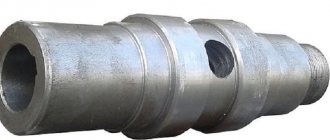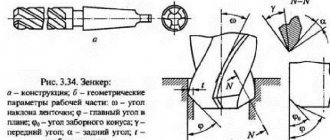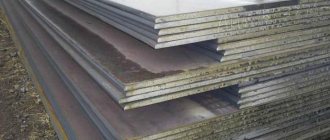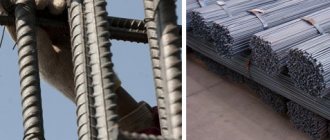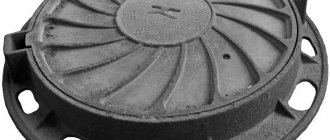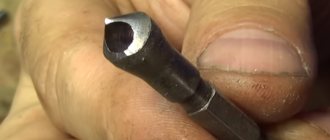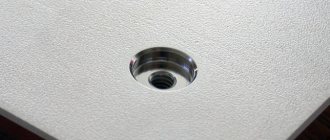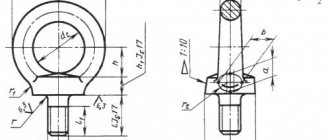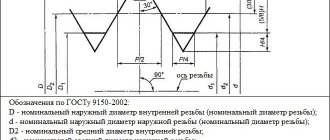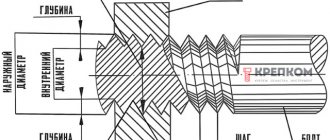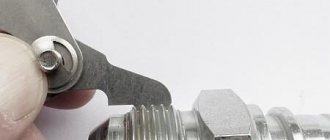In technology wrench is a specialized tool that is designed to assemble or disassemble threaded connections. To do this, they unscrew bolts or nuts from other parts, or screw them to them.
All wrenches in technology are divided into two main types: male and female. The holes into which nuts or bolt heads are inserted are called sheds, and their sizes are standardized . In the metric system they are measured in millimeters, and in the inch system they are measured in fractions of an inch.
Despite the fact that the design of a wrench is very simple and unpretentious, it finds extremely wide application: almost no assembly production can do without this tool; it is necessary when repairing a wide variety of equipment. There are spanners in space, for example, on the International Space Station.
If we talk about which of the many types of wrenches is more common than others, then open-end wrenches are, of course, the most common. As for the material used for their manufacture, the most common is high-quality tool steel, which contains chromium and vanadium as the main alloying additives.
GOST 6424 – 73
| Key holes and key sizes | |||||||
| Sizes S; S1; S2; S3 | Maximum deviations of key sizes | Maximum deviations of turnkey dimensions | |||||
| S | S1 | S2 | S3 | ||||
| Normal precision keys | Rough Precision Keys | High precision products | Products of normal accuracy | Rough precision products | |||
| 2,5* | – | – | −0,040 | – | – | – | +0,09 +0,03 |
| 3,0* | – | – | −0,040 | – | – | – | +0,09 +0,03 |
| 3,2 | +0,08 +0,02 | – | −0,048 | −0,16 | – | – | +0,12 +0,04 |
| 4,0 | +0,12 +0,02 | – | −0,048 | −0,16 | – | – | +0,12 +0,04 |
| 5,0 | +0,12 +0,02 | – | −0,048 | −0,16 | – | – | +0,12 +0,04 |
| 5,5 | +0,12 +0,02 | – | −0,048 | −0,16 | – | – | +0,12 +0,04 |
| 6,0* | +0,15 +0,03 | – | −0,048 | −0,16 | – | – | +0,12 +0,04 |
| 7,0 | +0,15 +0,03 | – | −0,058 | −0,20 | – | – | +0,15 +0,05 |
| 8,0 | +0,15 +0,03 | +0,18 +0,03 | −0,058 | −0,20 | −0,36 | – | +0,15 +0,05 |
| (9,0) | +0,15 +0,03 | +0,18 +0,03 | −0,058 | −0,20 | −0,36 | – | +0,15 +0,05 |
| 10,0 | +0,19 +0,04 | +0,24 +0,04 | −0,058 | −0,20 | −0,36 | – | +0,15 +0,05 |
| (11,0) | +0,19 +0,04 | +0,24 +0,04 | −0,120 | −0,24 | −0,43 | – | +0,18 +0,06 |
| 12,0 | +0,24 +0,04 | +0,30 +0,04 | −0,120 | −0,24 | −0,43 | – | +0,18 +0,06 |
| 13,0 | +0,24 +0,04 | +0,30 +0,04 | −0,120 | −0,24 | −0,43 | – | +0,18 +0,06 |
| 14,0 | +0,27 +0,05 | +0,35 +0,05 | −0,120 | −0,24 | −0,43 | – | +0,18 +0,06 |
| (15,0) | +0,27 +0,05 | +0,35 +0,05 | −0,120 | −0,24 | −0,43 | – | +0,18 +0,06 |
| 16,0 | +0,27 +0,05 | +0,35 +0,05 | −0,120 | −0,24 | −0,43 | – | +0,18 +0,06 |
| 17,0 | +0,30 +0,05 | +0,40 +0,05 | −0,120 | −0,24 | −0,43 | – | +0,18 +0,06 |
| 18,0 | +0,30 +0,05 | +0,40 +0,05 | −0,120 | −0,24 | −0,43 | – | +0,18 +0,06 |
| 19,0 | +0,36 +0,06 | +0,46 +0,06 | −0,140 | −0,28 | −0,52 | – | +0,21 +0,07 |
| 21,0 | +0,36 +0,06 | +0,46 +0,06 | −0,140 | −0,28 | −0,52 | – | +0,21 +0,07 |
| 22,0 | +0,36 +0,06 | +0,46 +0,06 | −0,140 | −0,28 | −0,52 | – | +0,21 +0,07 |
| 24,0 | +0,36 +0,06 | +0,46 +0,06 | −0,140 | −0,28 | −0,52 | – | +0,21 +0,07 |
| 27,0 | +0,48 +0,08 | +0,58 +0,08 | −0,140 | −0,28 | −0,52 | −0,84 | +0,21 +0,07 |
| 30,0 | +0,48 +0,08 | +0,58 +0,08 | −0,140 | −0,28 | −0,52 | −0,84 | +0,21 +0,07 |
| 32,0 | +0,48 +0,08 | +0,58 +0,08 | −0,170 | −0,34 | −1,00 | −1,00 | +0,25 +0,05 |
| 34,0 | +0,60 +0,10 | +0,70 +0,10 | −0,170 | −0,34 | −1,00 | −1,00 | +0,25 +0,05 |
| 36,0 | +0,60 +0,10 | +0,70 +0,10 | −0,170 | −0,34 | −1,00 | −1,00 | +0,25 +0,05 |
| 41,0 | +0,60 +0,10 | +0,70 +0,10 | −0,170 | −0,34 | −1,00 | −1,00 | +0,25 +0,05 |
| 46,0 | +0,60 +0,10 | +0,70 +0,10 | −0,170 | −0,34 | −1,00 | −1,00 | +0,25 +0,05 |
| 50,0 | +0,60 +0,10 | +0,70 +0,10 | −0,170 | −0,34 | −1,00 | −1,00 | +0,25 +0,05 |
| 55,0 | +0,72 +0,12 | +0,92 +0,12 | −0,200 | −0,40 | −1,20 | −1,20 | +0,30 +0,10 |
| 60,0 | +0,72 +0,12 | +0,92 +0,12 | −0,200 | −0,40 | −1,20 | −1,20 | +0,30 +0,10 |
| 65,0 | +0,72 +0,12 | +0,92 +0,12 | −0,200 | −0,40 | −1,20 | −1,20 | +0,30 +0,10 |
| 70,0 | +0,72 +0,12 | +0,92 +0,12 | −0,200 | −0,40 | −1,20 | −1,20 | +0,30 +0,10 |
| 75,0 | +0,85 +0,15 | +1,15 +0,15 | −0,200 | −0,40 | −1,20 | −1,20 | +0,30 +0,10 |
| 80,0 | +0,85 +0,15 | +1,15 +0,15 | −0,200 | −0,40 | −1,20 | −1,20 | +0,30 +0,10 |
| 85,0 | +0,85 +0,15 | +1,15 +0,15 | – | −0,87 | −1,40 | −1,40 | – |
| 90,0 | +0,85 +0,15 | +1,15 +0,15 | – | −0,87 | −1,40 | −1,40 | – |
| 95,0 | +0,85 +0,15 | +1,15 +0,15 | – | −0,87 | −1,40 | −1,40 | – |
| 100,0 | +0,85 +0,15 | +1,15 +0,15 | – | −0,87 | −1,40 | −1,40 | – |
| 105,0 | +1,00 +0,20 | +1,40 +0,20 | – | −0,87 | −1,40 | −1,40 | – |
| 110,0 | +1,00 +0,20 | +1,40 +0,20 | – | −0,87 | −1,40 | −1,40 | – |
| 115,0 | +1,00 +0,20 | +1,40 +0,20 | – | −0,87 | −1,40 | −1,40 | – |
| 120,0 | +1,00 +0,20 | +1,40 +0,20 | – | −0,87 | −1,40 | −1,40 | – |
| 130,0 | +1,25 +0,25 | +1,40 +0,20 | – | −0,87 | −1,40 | −1,40 | – |
| 135,0 | +1,00 +0,20 | +1,40 +0,20 | – | −1,00 | −1,60 | −1,60 | – |
| 145,0 | +1,25 +0,25 | +1,40 +0,20 | – | −1,00 | −1,60 | −1,60 | – |
| 150,0 | +1,25 +0,25 | +1,40 +0,20 | – | −1,00 | −1,60 | −1,60 | – |
| 155,0 | +1,25 +0,25 | – | – | −1,00 | −1,60 | −1,60 | – |
| 165,0 | +1,25 +0,25 | – | – | −1,00 | −1,60 | −1,60 | – |
| 170,0 | +1,25 +0,25 | – | – | −1,00 | −1,60 | −1,60 | – |
| 175,0 | +1,25 +0,25 | – | – | −1,00 | −1,60 | −1,60 | – |
| 180,0 | +1,25 +0,25 | – | – | −1,00 | −1,60 | −1,60 | – |
| 185,0 | +1,25 +0,25 | – | – | −1,15 | −1,90 | −1,90 | – |
| 200,0 | +1,25 +0,25 | – | – | −1,15 | −1,90 | −1,90 | – |
| 210,0 | +1,25 +0,25 | – | – | −1,15 | −1,90 | −1,90 | – |
| 225,0 | +1,50 +0,30 | – | – | −1,15 | −1,90 | −1,90 | – |
Making turnkey holes
In most cases, turnkey counter elements have hexagonal or square holes whose dimensions are specified by the standard. Unlike round holes, the technological process of their manufacture is much more complex and highly labor-intensive. These holes are most often the result of processes such as milling and broaching. In addition, to obtain them, equipment such as slotting machines is used, and specialized firmware is used. Recently, among other things, advanced methods such as electrical discharge machining and laser cutting have been used.
To get a square hole, you can use such a non-standard method as drilling using a specialized tool. This method is based on the trajectory of the cutting tool, called the “Reuleaux triangle”. It is named after its inventor, the French mechanical engineer Franz Releaux, who taught at the Berlin Royal Academy of Technology at the turn of the 20th century and eventually became its president. The essence of the “Reuleaux triangle” is that the cutting tool moves not in straight lines, but in arcs that have the same radius and size. If you use exactly this drill movement during the drilling process, you can get a square hole with slightly rounded corners.
APPENDIX 1 Mandatory 2 1
| Dimensions of keys for internal hexagon according to I CO 2986 | ||||||||
| GOST 11737-93 S. 7 APPENDIX 2 Mandatory PROTECTIVE AND DECORATIVE COATINGS
P. 8 'GOST Tt737-#3 |
Drilling
In technology, drilling means a technological process for which either spiral or other types of drills are used. The result of using this cutting tool is the formation of holes in parts, workpieces or semi-finished products that have a given diameter and a strictly defined depth.
In cases where turnkey holes , drilling is used as an auxiliary technological operation. It is necessary in order to pre-process the hole.
Nut size and main types of nuts
There are several main types of nuts:
- Hex or Flat Nut: A versatile, general purpose part.
- Lock nut: Used for enhanced safety when the nut should not come loose due to
vibration or other constant loads.
- Cone Nut: Used to center objects.
- Groove or Castle Nut: Used in conjunction with a cotter pin on objects that turn or twist.
- Cap Nut: Used to create a finished look by capping the end of the thread.
- Wing Nut: Used when tightening a joint by hand.
Measuring thread pitch without a thread gauge
Parts with external thread
Often the need to determine the thread pitch arises sporadically, at one time. And, of course, in such a situation there is no thread gauge at hand, and it makes no sense to buy one for one-time measurements. It will be useful to learn how to measure the thread pitch with a ruler or caliper. These measuring tools make it quite easy to determine the desired parameter.
The easiest way is to measure the threads of a bolt or other externally threaded part. When measuring a metric thread, it is recommended that you first attach the ruler to the threaded part and try to align the millimeter divisions of its scale with the tops of the ridges of the threaded profile. If they coincide, then the step is 1 mm. Otherwise, you will have to carry out slightly more complex measurements.
To determine the thread pitch, you need to count the number of turns on a section of a rod of a certain length, for example, 10 mm or 20 mm. To obtain a more accurate result, it is recommended to take measurements on a 20 mm area. The required length is measured by applying a ruler to the bolt shaft, or using a caliper. It would be more accurate to measure the bolt thread pitch with a caliper. In the measured area, count the number of turns. After this, the length of the section must be divided by the resulting number of turns minus one turn. As a result, we obtain the value of the thread pitch.
When determining the pitch of an inch cutting, it is necessary to measure the length of the rod equal to one inch (25.4 mm). For accurate measurements, it is better to use a ruler or caliper with an inch scale. The number of turns in this area will be the thread pitch. If the length of the threaded section is less than one inch, then you need to determine the number of turns in a section of half an inch (12.7 mm), and then multiply the result by 2.
Internally threaded parts
There are two ways to measure the thread of a nut or other internally threaded part without a thread gauge. The first method involves selecting an exactly suitable counter bolt and then measuring its thread pitch. If you can’t find the counter bolt, then you need to use a strip of paper (this is method No. 2).
It should be pressed against the thread so that an imprint of the profile remains on the paper. You can improve the visibility of marks by tracing the edges with a marker. After this, on paper you need to mark the distance between the extreme marks with a ruler and count the number of turns. Then the resulting distance is divided by the number of turns minus one turn. Instead of measuring paper using this method, you can use a pencil, match or other soft wood product of a suitable size, which is pressed against the thread.
Measuring thread pitch without a thread gauge
Parts with external thread
Often the need to determine the thread pitch arises sporadically, at one time. And, of course, in such a situation there is no thread gauge at hand, and it makes no sense to buy one for one-time measurements. It will be useful to learn how to measure the thread pitch with a ruler or caliper. These measuring tools make it quite easy to determine the desired parameter.
The easiest way is to measure the threads of a bolt or other externally threaded part. When measuring a metric thread, it is recommended that you first attach the ruler to the threaded part and try to align the millimeter divisions of its scale with the tops of the ridges of the threaded profile. If they coincide, then the step is 1 mm. Otherwise, you will have to carry out slightly more complex measurements.
To determine the thread pitch, you need to count the number of turns on a section of a rod of a certain length, for example, 10 mm or 20 mm. To obtain a more accurate result, it is recommended to take measurements on a 20 mm area. The required length is measured by applying a ruler to the bolt shaft, or using a caliper. It would be more accurate to measure the bolt thread pitch with a caliper. In the measured area, count the number of turns. After this, the length of the section must be divided by the resulting number of turns minus one turn. As a result, we obtain the value of the thread pitch.
When determining the pitch of an inch cutting, it is necessary to measure the length of the rod equal to one inch (25.4 mm). For accurate measurements, it is better to use a ruler or caliper with an inch scale. The number of turns in this area will be the thread pitch. If the length of the threaded section is less than one inch, then you need to determine the number of turns in a section of half an inch (12.7 mm), and then multiply the result by 2.
Inch wrenches and sockets will come in handy if you repair or use American equipment. Equipment from the USA has become widespread in our country in recent years: American tractors, cars, agricultural machinery. In addition, American units, engines and transmissions, are installed by many manufacturers from other countries, including Russian ones.
If the mount is new and unworn, and the standard tools “do not fit a little”: the smaller size does not fit, and the next one is loose. In such cases, there is a high probability that you need inch keys.
If you are repairing or working on equipment with inch fasteners, you should definitely purchase a set of inch wrenches, a set of inch sockets and, if necessary, a set of inch hexagons.
To help you better understand inch sizes, below is a conversion chart to the metric system.
| INCH | MM | INCH | MM | INCH | MM | INCH | MM | INCH | MM |
| 1/32 | 0,7938 | 1-1/32 | 26,1938 | 2-1/32 | 51,594 | 3-1/32 | 76,9938 | 4-1/32 | 102,3938 |
| 1/16 | 1,5875 | 1-1/16 | 26,9875 | 2-1/16 | 52,388 | 3-1/16 | 77,7875 | 4-1/16 | 103,1875 |
| 3/32 | 2,3812 | 1-3/32 | 27,7812 | 2-3/32 | 53,181 | 3-3/32 | 7835812 | 4-3/32 | 103,9812 |
| 1/8 | 3,1750 | 1-1/8 | 28,5750 | 2-1/8 | 53,9750 | 3-1/8 | 79,3750 | 4-1/8 | 104,7750 |
| 5/32 | 3,9688 | 1-5/32 | 29,3688 | 2-5/32 | 54,769 | 3-5/32 | 80,1688 | 4-5/32 | 105,5688 |
| 3/16 | 4,7625 | 1-3/16 | 30,1625 | 2-3/16 | 55,563 | 3-3/16 | 80,9625 | 4-3/16 | 106,3625 |
| 7/32 | 5,5562 | 1-7/32 | 30,9562 | 2-7/32 | 56,356 | 3-7/32 | 81,7562 | 4-7/32 | 107,1562 |
| 1/4 | 6,3500 | 1-1/4 | 31,7500 | 2-1/4 | 53,1500 | 3-1/4 | 82,5500 | 4-1/4 | 107,9500 |
| 9/32 | 7,1438 | 1-9/32 | 32,5438 | 2-9/32 | 57,944 | 3-9/32 | 83,3438 | 4-9/32 | 108,7438 |
| 5/16 | 7,9375 | 1-5/16 | 33,3375 | 2-5/16 | 58,738 | 3-5/16 | 84,1375 | 4-5/16 | 109,5375 |
| 11/32 | 8,7312 | 1-11/32 | 34,1312 | 2-11/32 | 59,531 | 3-11/32 | 84,9312 | 4-11/32 | 110,3312 |
| 3/8 | 9,5250 | 1-3/8 | 34,9250 | 2-3/8 | 60,3250 | 3-3/8 | 85,7250 | 4-3/8 | 111,1250 |
| 13/32 | 10,3188 | 1-13/32 | 35,7188 | 2-13/32 | 61,119 | 3-13/32 | 86,5188 | 4-13/32 | 111,9188 |
| 7/16 | 11,1125 | 1-7/16 | 36,5125 | 2-7/16 | 61,9125 | 3-7/16 | 87,31,25 | 4-7/16 | 112,7125 |
| 15/32 | 11,9062 | 1-15/32 | 37,3062 | 2-15/32 | 62,7062 | 3-15/32 | 88,1062 | 4-15/32 | 113,5062 |
| 1/2 | 12,7000 | 1-1/2 | 38,1000 | 2-1/2 | 63,5000 | 3-1/2 | 88,9000 | 4-1/2 | 114,3000 |
| 17/32 | 13,4938 | 1-17/32 | 38,8938 | 2-17/32 | 64,2938 | 3-17/32 | 89,6938 | 4-17/32 | 115,0938 |
| 9/16 | 14,2875 | 1-9/16 | 39,6875 | 2-9/16 | 65,0875 | 3-9/16 | 90,4875 | 4-9/16 | 115,8875 |
| 19/32 | 15,0812 | 1-19/32 | 40,4812 | 2-19/32 | 65,8812 | 3-19/32 | 91,2812 | 4-19/32 | 116,6812 |
| 5/8 | 15,8750 | 1-5/8 | 41,2750 | 2-5/8 | 66,6750 | 3-5/8 | 92,0750 | 4-5/8 | 117,4750 |
| 21/32 | 16,6688 | 1-21/32 | 42,0688 | 2-21/32 | 67,4688 | 3-21/32 | 92,8688 | 4-21/32 | 118,2688 |
| 11/16 | 17,4625 | 1-11/16 | 42,8625 | 2-11/16 | 68,2625 | 3-11/16 | 93,6625 | 4-11/16 | 119,0625 |
| 23/32 | 18,2562 | 1-23/32 | 43,6562 | 2-23/32 | 69,0562 | 3-23/32 | 94,4562 | 4-23/32 | 119,8562 |
| 3/4 | 19,0500 | 1-3/4 | 44,4500 | 2-3/4 | 69,8500 | 3-3/4 | 95,2500 | 4-3/4 | 120,4500 |
| 25/32 | 19,8438 | 1-25/32 | 45,2438 | 2-25/32 | 70,6438 | 3-25/32 | 96,0438 | 4-25/32 | 121,4438 |
| 13/16 | 20,6375 | 1-13/16 | 46,0375 | 2-13/16 | 71,4375 | 3-13/16 | 96,8375 | 4-13/16 | 122,2375 |
| 27/32 | 21,4312 | 1-27/32 | 46,8312 | 2-27/32 | 72,2312 | 3-27/32 | 97,6312 | 4-27/32 | 123,0312 |
| 7/8 | 22,2250 | 1-7/8 | 47,6250 | 2-7/8 | 73,0250 | 3-7/8 | 98,4250 | 4-7/8 | 123,8250 |
| 29/32 | 23,0188 | 1-29/32 | 48,4188 | 2-29/32 | 73,8188 | 3-29/32 | 99,2188 | 4-29/32 | 124,6188 |
| 15/16 | 23,8125 | 1-15/16 | 49,2125 | 2-15/16 | 74,6125 | 3-15/16 | 100,0125 | 4-15/16 | 125,4125 |
| 31/32 | 24,6062 | 1-31/32 | 50,0062 | 2-31/32 | 75,4062 | 3-31/32 | 100,8062 | 4-31/32 | 126,2062 |
| 1 | 25,4000 | 2 | 50,8000 | 3 | 76,2000 | 4 | 101,6000 | 5 | 127,0000 |
Linear dimensions measurements
How to measure linear dimensions using a caliper? It all depends on the material of the part/workpiece. For rigid elements, the product is pressed tightly against some support plate, after which the measurement is taken with the external measuring jaws of the tool. You must first determine the suitability of the existing type of caliper for use. For example, the main measuring scale on the rod should be less than 25...30 mm longer than the part (taking into account the own width of the jaws). When using a depth gauge, this value is even smaller, since the length of the frame should also be taken into account (for the most common tools 0-150 mm and an accuracy of 0.05 to 0.1 mm, this parameter is taken to be at least 50 mm).
How to measure the cross-section of a wire with a caliper? Non-metallic products are flexible, and therefore significantly distort the result obtained in the usual way. Therefore, a rigid steel part (screw, nail, piece of rod) should be inserted into the cambric, and then the cross-sectional diameter of the wire should be determined using external jaws. Do the same if you need to find out the internal size of the wire.
Wire diameter measurement
The question - how to measure a chain with a caliper - is often asked by cyclists, since chain wear, defined as the distance between its adjacent links, makes it possible to decide whether to replace the product. The outer jaws are set at a distance of 119 mm and inserted into the link, after which they are stretched to the sides until further increase in size is impossible (to facilitate the work, the chain can be pre-loaded with a tensile force). The deviation from the original size will show actual wear, which must then be compared with the maximum allowable.
